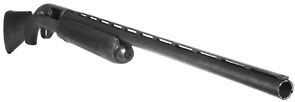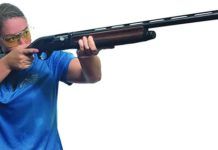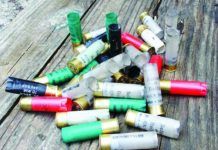
Some of the most difficult shots taken in wingshooting situations aren’t even attempted with Roman candle-size 3- and 3.5-inch shotshells. No, the best shooters in the world, competing in Sporting Clays events, regularly make 50- and 60-yard shots on nigh-impossible targets with guns chambered for the standard-length 2.75-inch-long shotshell. They know, as do many hunters, that the right round in the right hands will do much more than a bigger, poorly placed charge.
Certainly, 2.75-inch-only guns are in the minority nowadays, but a few of them can still be had, usually at a mild discount off longer-chambered shotguns. We recently got to test two such inexpensive semiautos that offer a lot of performance for the dollar.
The first gun was the $260 Lanber Model 2532 12 gauge, available from CDNN, (800) 588-9500 or cdnninvestments.com. This gun had a 28-inch barrel, a walnut stock, and it came with one Modified choke tube with tool. (A similar gun that shoots 3-inchers costs $30 more.) Also, we tested a Remington 1100 12 Gauge Model 25369, which MSRPs for $540. This gun was likewise configured with a 28-inch barrel, and it too came with a single Modified choke. A similarly configured Model 11-87 SPS that shoots 3-inch shells costs $756, though some of that extra cost can certainly be attributed to the 11-87’s better accessory package.
We shot the Remington and Lanber guns at a variety of skeet, Sporting, and Five Stand targets to see which one we would buy if we only needed a gun with a 2.75-inch chamber. Our test rounds included Remington’s Shurshot Heavy Dove Load R12HD8 (3 1/4 dram equivalent; 1 1/8-ounce shotcharge of No. 8s); Winchester AA Super Sport Sporting Clays load AASC127 (1 1/8-ounce shotcharge of No. 7 1/2s); and Winchester’s AA129 AA Light Target Load, which is a 2 3/4 dram equivalent shell with 1 1/8 ounces of No. 9 shot.
Here’s what we learned:
Remington 1100 12 Gauge No. 25369, $540
The 1100 gas-operated autoloading shotgun, designed by Wayne Leek, has been in production since 1963, according to Remington records. The 12 gauge was the first model to roll out that year, followed by a 16 gauge in 1964 and a 20 gauge and .410 bore in 1969. Several grades have been offered, including specialized Skeet and Trap versions, and variations have included a Magnum Duck Gun, left-hand guns in 12 and 20 gauge, and others.
Our test gun was the 2.75-inch-chamber Model 25369, which measured 48 inches in overall length with a barrel 28.0 inches long. The LOP measured 14.0 inches. Drop at the comb was 1.5 inches; drop at the heel was 2.5 inches.
The synthetic stock was matte black, as was the metal finish on the action and barrel. Unloaded, the gun weighed 7 pounds. It had a capacity of four shotshells. The autoloading action is gas driven. The trigger pull measured a crisp 5 pounds at the break. The gun came with a choke-tube wrench.
The 1100’s pistol grip featured pressed checkering that afforded a decent grip, even when the gun was wet. The fit at the buttpad was sloppy, and the top of the rubber pad had not been ground for easier mounting. But the black-rubber pad offered much better cushioning than the Lanber, we thought. The beavertail forend was medium width and wiggled slightly side to side.
Of course, this is not a gun for which cosmetics are a major concern. It is made to shoot in extreme conditions and like it. Thus, we were disconcerted when rust showed up on the steel receiver’s scrollwork after we had shot the gun in a driving rain.
The trigger guard was aluminum. As noted, the receiver featured minor scrollwork on each sideplate. The ventilated rib was machined evenly, and its nonglare pattern was extremely effective at killing reflected sunlight, we thought. The rib was 7mm wide. The matte silver front-sight bead was unobtrusive. During our shooting, the 1100 handled all the test rounds perfectly.
The Remington had a couple of advantages which ultimately made it our pick over the Lanber. The pistol grip’s angle relative to the trigger was very comfortable for all our test shooters. Even when shotgunners switched from what they normally shot to this gun, they adapted easily to the 14.0-inch LOP on this stock. The thin trigger, which broke at 5 pounds, was positive and sure. We think this was a prime factor in our learning how to shoot this gun well, and fast.
On the downside, the Remington is somewhat more expensive. Though its MSRP is more than twice what the Lanber sells for, street price on the 1100 is more like $450.
Lanber Model 2532 12 Gauge, $260
Lanber Shotguns are imported by ITC International, Inc., 1720 Cumberland Point Dr., Suite 5, Marietta, GA 30067, (770) 858-0048. The company’s guns are manufactured in Spain.
This 12 gauge had an overall length of 48.25 inches, the bulk of which was the 28.0-inch-long barrel. The gun’s LOP was 14.25 inches, and it had 1.5 inches of drop at the comb and 2.0 inches of drop at the heel.
The stock was a nicely figured walnut with a matte clearcoat, in which we saw no blemishes. The metal finish on the barrel was polished blued steel, which likewise was well applied. Unloaded, the gun weighed 6.8 pounds and had a capacity of four shells. We thought the trigger broke indistinctly at 9.0 pounds.
The Lanber’s pistol grip was noticeably thicker and slicker than the 1100’s, a function of the low-point checkering and smooth clearcoat combining to cause a problem. The fit at the buttpad was smooth, but the plastic buttplate itself had sharp edges and sharp points in its checkering that dug into the shooter’s shoulder. If we were to buy this gun, we would immediately put a soft rubber buttpad on it. The beavertail forend felt thick, but it fit firmly on the gun, unlike the Remington. We preferred the shape of the Remington’s forend, however, which had a groove for the thumb and pointing finger to rest in.
Cosmetically, this gun had it all over the Remington. We were pleased at the fit and finish overall, and the wood was easily the best we’ve ever seen on a $260 shotgun. Two other niceties the Lanber had that the Remington lacked were sling swivels on the magazine cap and in the buttstock.
The receiver and trigger guard were aluminum, and the sides of the receiver featured painted game scenes. The ventilated rib had been crosscut to eliminate glare, and it was effective enough. The rib was 7mm wide. The front sight was a red-plastic insert screwed onto the rib. It looked sturdy.
During our shooting, the Lanber handled all the test rounds perfectly, as did the Remington. We were surprised that neither gun choked on the light Winchester load, and shooting that load in the Lanber made the gun much more comfortable to shoot because of the buttplate. We liked the Lanber’s controls, which sit on the right side of the gun. The bolt catch lever sits just in front of the trigger guard, and depressing it kept the bolt open once the shooter pulled back on the chromed bolt handle. To release the bolt, the shooter pushes a prominent red button on the receiver, and the bolt jumps forward. We thought this was very simple to use.
At the range, our shooters had more trouble getting used to the Lanber than to the Remington. One of the more interesting things we do in testing is to put a gun cold in a shooter’s hands and tell him to fire away, but keep score. For good shooters who have had their stocks fit, this is a telling test. They often take a few rounds to get up to speed, but if a gun’s dimensions are “average” enough to accommodate a range of shooting styles, we usually see them start breaking a lot of targets quickly.
However, we didn’t see this as much with the Lanber. Likely, it was a combination of stockfit and trigger pull that depressed our performance with the gun. Timing is a crucial aspect of shotgunning, and if the trigger doesn’t cooperate, it makes the entire shooting system go to pot. In our view, that’s what happened with the Lanber.
Gun Tests Recommends
Lanber Model 2532 12 Gauge, $260. Conditional Buy. There was a lot to like about this gun: great wood, fine metal finish, perfect operation, decent handling. But we think it needs a new buttpad and a trigger job. Some shooters might also benefit from cutting the stock down a quarter to a half inch.
Remington 1100 12 Gauge No. 25369, $540. Buy It. This is a working shotgun by virtue of its synthetic stocks and flat-black presentation. If you only need the performance of 2.75-inch shells, then we wouldn’t hesitate to buy the 1100.




























